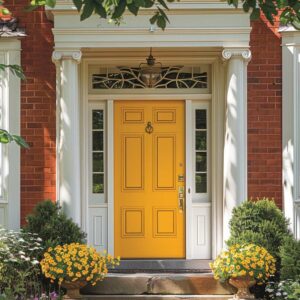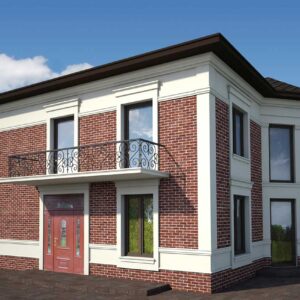In the realm of architecture, Brutalism stands out for its bold, raw, and unapologetic approach to design. This architectural style, characterized by its use of rugged materials and stark, geometric forms, makes a powerful statement that can transform the aesthetic of any space, including the compound walls that define the boundaries of our homes. Embracing Brutalist principles in compound wall design not only enhances security and privacy but also elevates the property’s visual impact, making it a remarkable architectural feature in its own right.
Concrete Mastery in Compound Wall Design for a Bold Look




In the realm of architectural design, Brutalism stands out for its bold, unapologetic use of raw concrete and stark, geometric forms. A compound wall that embodies this style is not just a boundary but a statement of aesthetic confidence and architectural integrity. The mastery of concrete as a material in such a design speaks volumes about the blend of functionality and artistry that characterizes Brutalist architecture.
The design of a Brutalist compound wall is rooted in the celebration of concrete’s raw texture and the imposing presence it commands in a space. Unlike other materials that might be chosen for their ability to blend or hide, concrete is selected for its honest expression and the stark contrast it creates against the natural landscape. This compound wall design leverages the material’s natural color variations, weathering patterns, and tactile surface to craft an experience that is both visual and visceral.
Incorporating geometric precision into the compound wall elevates the structure from a mere functional boundary to a sculptural piece that interacts with its environment. The play of light and shadow across the wall’s surfaces throughout the day brings it to life, highlighting the dynamic nature of Brutalist designs. This interaction not only enhances the wall’s aesthetic appeal but also underscores the philosophy of Brutalism, where structures are designed to be as much a part of the human experience as they are of the landscape.




Yet, the mastery of concrete in compound wall design is not solely about the boldness of form or the tactile allure of texture. It also lies in the material’s versatility and its ability to be molded into structures that defy traditional architectural expressions. This allows for the creation of compound walls that are not just barriers but are integral elements of the property’s overall design narrative, contributing to a cohesive aesthetic vision that is both grounded and groundbreaking.
Embracing concrete mastery in compound wall design invites a dialogue between the structure and its surroundings, where the wall becomes a canvas reflecting the changing patterns of light and season. It’s a testament to the enduring power of Brutalist architecture, where the raw, unrefined beauty of concrete is not just accepted but celebrated for its bold, uncompromising character.
Through such designs, we are reminded of the transformative potential of architecture to challenge perceptions, invite engagement, and elevate the mundane into the realm of art. A Brutalist compound wall, with its mastery of concrete and geometric precision, stands as a bold statement of design philosophy, where strength and elegance coalesce to redefine the boundaries of traditional aesthetic norms.
Geometric Precision in Brutalist Compound Wall Structures




The essence of Brutalism is often captured in the stark, geometric precision of its structures, a principle that lends itself beautifully to the design of compound walls. These walls, emblematic of Brutalist architecture, stand as a testament to the power of shape and form in creating profound architectural statements. The geometric precision in these designs is not merely about the aesthetic; it’s a deliberate choice that reflects the ideology of Brutalism—honesty in materials, functionality, and form.
In envisioning a compound wall inspired by this principle, one must appreciate the deliberate juxtaposition of simple forms to achieve complex visual and functional outcomes. The design starts with the basic geometries—cubes, rectangles, and cylinders—crafted from concrete. These shapes are then arranged in a manner that challenges conventional perceptions of space and boundary. The wall becomes a montage of forms, each chosen for its ability to interact with light and shadow, creating a dynamic play that evolves throughout the day.
This geometric precision is not merely for aesthetic appeal but serves a deeper purpose. It breaks the monotony of the urban landscape, providing visual interest and drawing the observer’s eye not just to the structure itself but to the interaction of forms. The design intentionally leverages the Brutalist ethos of functionality, with each geometric shape contributing to the wall’s structural integrity and its ability to provide privacy, security, and sound insulation.




Moreover, the incorporation of geometric precision in compound wall design speaks to a broader architectural dialogue about the relationship between form and environment. The stark lines and shapes of the wall contrast with the organic forms of nature, creating a dialogue between the built and the natural world. This interaction is at the heart of Brutalist design, where the rawness of materials and the boldness of forms are seen as complementary to, rather than dominating, the landscape.
Embracing geometric precision in the design of a Brutalist compound wall thus becomes an exploration of the possibilities of concrete and geometry. It is an affirmation of the belief that beauty lies in the raw, unadorned simplicity of forms and in the honest expression of materials. Such a wall does not just define a boundary; it challenges the observer to see beyond the conventional, to appreciate the elegance in starkness, and to find harmony in the contrast between the geometric and the organic.
In this context, the design of a compound wall becomes a reflection of broader architectural and philosophical ideals. It embodies the Brutalist commitment to material honesty, structural functionality, and geometric clarity, making a bold statement that resonates within the fabric of the urban landscape. Through the precise arrangement of simple geometric forms, the compound wall transcends its utilitarian purpose, becoming a symbol of architectural integrity and a canvas for the interplay of light, shadow, and form.
Raw Elegance of Brutalist Design in Contemporary Compound Walls




In the landscape of contemporary architecture, the raw elegance of Brutalist design finds a renewed expression in compound wall constructions. This style, characterized by its unrefined materials and stark, geometric forms, challenges traditional notions of beauty and elegance, proposing instead a vision of aesthetic integrity grounded in truthfulness to materials and structural honesty. The raw elegance of Brutalist compound walls is a testament to the enduring relevance of this architectural philosophy, demonstrating how spaces can be defined with both strength and subtlety.
The essence of this approach lies in celebrating the inherent beauty of construction materials, primarily concrete, in their most unadorned state. The texture, color variations, and imperfections of concrete are not concealed but are brought to the forefront, serving as the primary elements of design. This honesty in materiality speaks to a deeper appreciation for the tactile and visual qualities of architecture, where the value is placed not on ornamentation but on the expressive potential of raw materials.
The design of such compound walls goes beyond mere aesthetic considerations; it embodies a commitment to functionality and durability. The solid, impenetrable nature of concrete offers unparalleled security and privacy, while its resistance to elements speaks to the practical demands of boundary walls. Yet, within this functionality, there is a profound sense of beauty. The way light plays off the uneven surfaces, casting shadows that transform throughout the day, brings a dynamic quality to these structures, making them ever-changing works of art.
Integrating raw elegance into contemporary compound walls also involves a thoughtful consideration of the wall’s interaction with its environment. In contrast to the lushness of natural landscapes, the starkness of concrete creates a compelling visual dialogue, one that highlights the contrast between the made and the natural world. This interaction enriches the aesthetic experience of the space, demonstrating how Brutalist principles can enhance, rather than detract from, the beauty of their surroundings.




Moreover, the application of Brutalist design principles in contemporary compound walls reflects a broader cultural appreciation for minimalism and sustainability. By focusing on the raw beauty of materials and the elegance of simple forms, these walls embody a form of architectural restraint that is both environmentally responsible and visually striking.
In conclusion, the raw elegance of Brutalist design in contemporary compound walls represents a nuanced balance between strength and beauty, functionality and artistry. It is a celebration of the material as much as it is a statement of design philosophy, offering a vision of architectural elegance that is deeply rooted in the honesty and integrity of its construction. Through these structures, Brutalism continues to challenge and inspire, proving that true elegance lies in the authentic expression of materials and forms.
Adopting Brutalist design principles for compound walls is a daring move that pays off by setting a property apart with its distinct identity and architectural depth. This approach is not for the faint-hearted; it demands attention and respect, reflecting the strength and stability of the materials from which it’s crafted. A Brutalist compound wall is more than a barrier; it’s a statement of aesthetic confidence, a nod to the beauty of raw, unrefined materials, and a tribute to geometric precision. It embodies the essence of Brutalism — powerful, uncompromising, and profoundly impactful.












